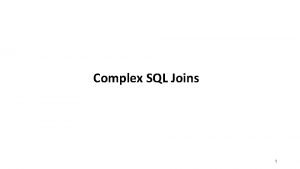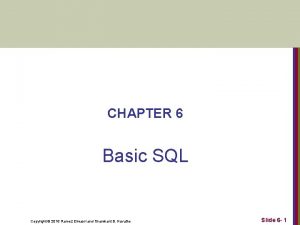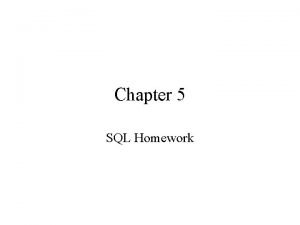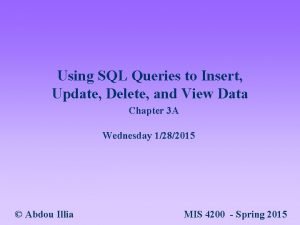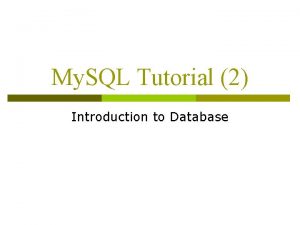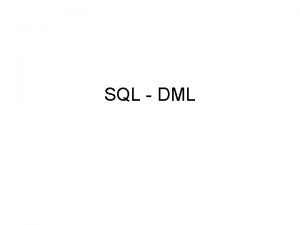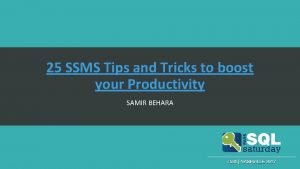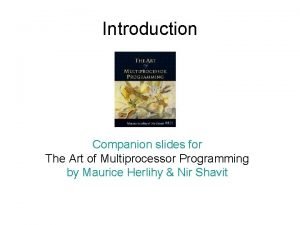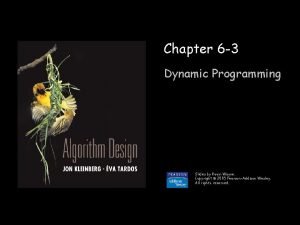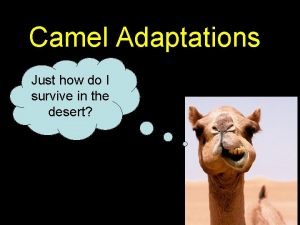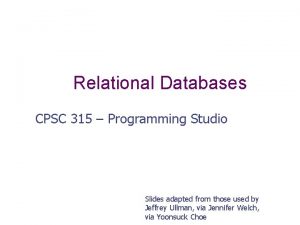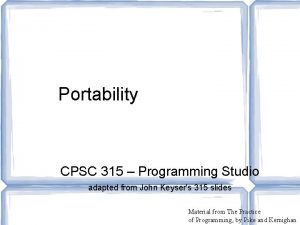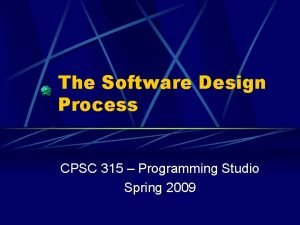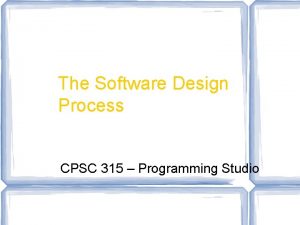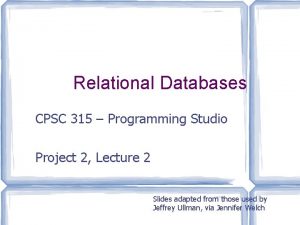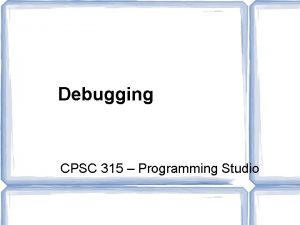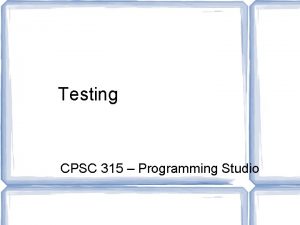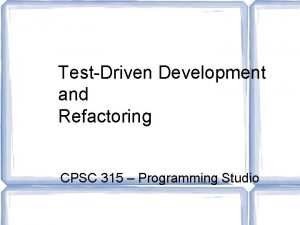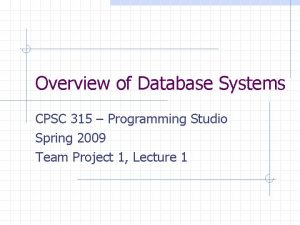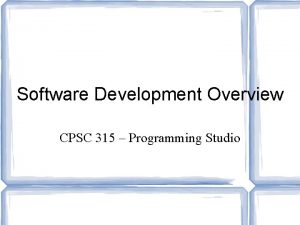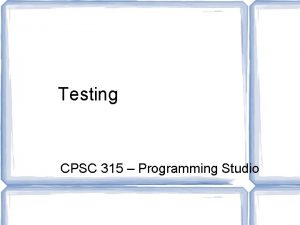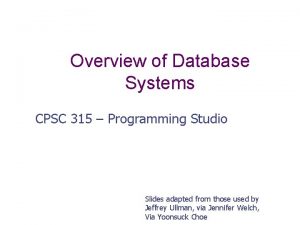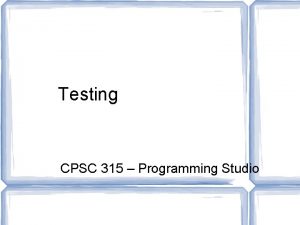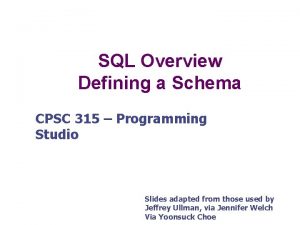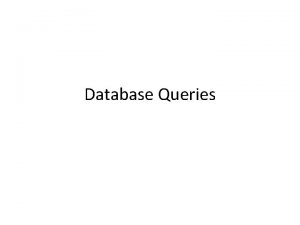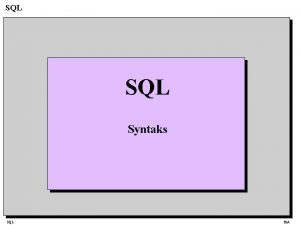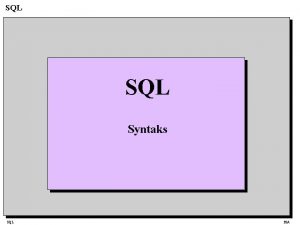SQL Queries CPSC 315 Programming Studio Slides adapted






































- Slides: 38

SQL Queries CPSC 315 – Programming Studio Slides adapted from those used by Jeffrey Ullman, via Jennifer Welch, via Yoonsuck Choe

Queries The heart of SQL Queries can form portion of other commands e. g. INSERT results of a query into a table Form: SELECT attributes FROM relation(s) WHERE condition

Example Senator: Query: Name Party Jill Smith Republican NY 5 Joe Adams Democrat NJ 0 Sue Jones Democrat CT 9 Jim Brown Republican PA SELECT Name FROM Senator WHERE Party = ‘Republican’; Result: Name Jill Smith Jim Brown State Years 15

Statement Processing Begin with the relation(s) in the FROM clause Can be the result of another query! Apply selection condition in WHERE clause Can potentially be very complex, and include subqueries Get the attributes given in (more generally, apply a projection to) the SELECT clause Process: iterate through all tuples in FROM, checking vs. WHERE, and for those that match, apply the SELECT

SELECT Clause - * Can use a * for SELECT to indicate all attributes given in the relation listed in FROM. Name Party State Years 5 Senator: Jill Smith Republican NY Query: Joe Adams Democrat NJ 0 Sue Jones Democrat CT 9 Jim Brown Republican PA 15 State Years SELECT * FROM Senator WHERE Party = ‘Republican’; Result: Name Party Jill Smith Republican NY 5 Jim Brown Republican PA 15

SELECT Clause - AS Can use AS to rename attributes in result Party State Years Senator: Name Query: Jill Smith Republican NY 5 Joe Adams Democrat NJ 0 Sue Jones Democrat CT 9 Jim Brown Republican PA 15 SELECT Name AS Person, Party AS Affiliation, State FROM Senator WHERE Party = ‘Republican’; Result: Person Affiliation State Jill Smith Republican NY Jim Brown Republican PA

SELECT Clause Expression Can include expressions in SELECT Clause Name Party State Years Senator: Jill Smith Republican NY 5 Joe Adams Democrat NJ 0 Sue Jones Democrat CT 9 Jim Brown Republican PA 15 Query: SELECT Name, Years * 365 AS Days. In. Office FROM Senator WHERE Party = ‘Republican’; Name Days. In. Office Result: Jill Smith 1825 Jim Brown 5475

SELECT Clause - Constants Can include constant attributes Party State Senator: Name Query: Jill Smith Republican NY 5 Joe Adams Democrat NJ 0 Sue Jones Democrat CT 9 Jim Brown Republican PA 15 SELECT Name, ‘Senator’ AS Office. Held FROM Senator WHERE Party = ‘Republican’; Result: Years Name Office. Held Jill Smith Senator Jim Brown Senator

Aggregations SUM, AVG, COUNT, MIN, MAX COUNT(*) counts number of tuples Applied to column in SELECT clause Use DISTINCT to eliminate duplicates NULLs are ignored If Aggregation is used, every selected column must be aggregated or in the GROUP BY list

Grouping Aggregations Adding GROUP BY <attribute> at the end will apply aggregation only to group e. g. to get the total number of U. S. Representatives from each state: SELECT State, COUNT(*) FROM USRepresentatives GROUP BY State

HAVING Can restrict GROUP using HAVING can refer to the FROM clause and its attributes e. g. Count representatives by state, only if all representatives have 3 years experience SELECT State, COUNT(*) FROM USRepresentatives GROUP BY State HAVING MIN(Years) > 3

WHERE Clause – Complex Expressions Can include NOT, AND, OR operators Party State Years Senator: Name Query: Jill Smith Republican NY 5 Joe Adams Democrat NJ 0 Sue Jones Democrat CT 9 Jim Brown Republican PA SELECT * FROM Senator WHERE Party = ‘Republican’ OR Years > 3; Result: 15 Name Party State Years Jill Smith Republican NY 5 Sue Jones Democrat CT 9 Jim Brown Republican PA 15

WHERE Clause – other effects Order of operations, including parentheses LIKE: String comparisons with wildcards % means any string _ means any character

WHERE Clause – NULL values Tuples may contain NULL values Undefined/Unknown Inapplicable All conditions evaluate to either TRUE, FALSE, or UNKNOWN Comparisons to NULL are UNKNOWN Tuples selected only if TRUE

3 -valued Logic Can think of values as Operations would be OR = MAX AND = MIN NOT = 1 -x Example: (T AND ((NOT U OR F) AND NOT (U OR T))) TRUE = 1 FALSE = 0 UNKNOWN = ½

3 -valued Logic Can think of values as Operations would be OR = MAX AND = MIN NOT = 1 -x Example: (T AND ((NOT U OR F) AND NOT (U OR T))) MAX(1 - ½, 0) = MAX(½, 0) = ½ = U TRUE = 1 FALSE = 0 UNKNOWN = ½

3 -valued Logic Can think of values as TRUE = 1 FALSE = 0 UNKNOWN = ½ Operations would be OR = MAX AND = MIN NOT = 1 -x Example: (T AND (U AND NOT (U OR T)))

3 -valued Logic Can think of values as Operations would be OR = MAX AND = MIN NOT = 1 -x Example: (T AND (U AND NOT (U OR T))) MAX(½, 1) = 1 = T TRUE = 1 FALSE = 0 UNKNOWN = ½

3 -valued Logic Can think of values as TRUE = 1 FALSE = 0 UNKNOWN = ½ Operations would be OR = MAX AND = MIN NOT = 1 -x Example: (T AND (U AND NOT T)

3 -valued Logic Can think of values as Operations would be OR = MAX AND = MIN NOT = 1 -x Example: (T AND (U AND NOT T) ) MIN(½, 1 -1) = MIN(½, 0) = 0 = F TRUE = 1 FALSE = 0 UNKNOWN = ½

3 -valued Logic Can think of values as TRUE = 1 FALSE = 0 UNKNOWN = ½ Operations would be OR = MAX AND = MIN NOT = 1 -x Example: (T AND F)

3 -valued Logic Can think of values as Operations would be OR = MAX AND = MIN NOT = 1 -x Example: (T AND F) MIN(0, 1) = 0 = F TRUE = 1 FALSE = 0 UNKNOWN = ½

3 -valued Logic Can think of values as Operations would be OR = MAX AND = MIN NOT = 1 -x Example: F (T AND ((NOT U OR F) AND NOT (U OR T))) TRUE = 1 FALSE = 0 UNKNOWN = ½

Unexpected Results for NULLs WHERE (Years > 2) OR (Years < 3) This should “cover” all cases If Years is NULL Years > 2 is UNKNOWN Years < 3 is UNKNOWN So the OR is UNKNOWN And thus the tuple is NOT selected!

WHERE Clause – IN operator <tuple> IN <relation> TRUE iff the tuple is a member of the relation SELECT * FROM Elected. Official WHERE Name IN USRep Result Name Party Chet Edwards Democrat Ron Paul Republican Elected. Official Name Party Chet Edwards Democrat John Cornyn Republican John Adams Federalist Ron Paul Republican USRep Name Ron Paul Chet Edwards

WHERE Clause – EXISTS operator EXISTS (<relation>) TRUE iff the relation is not empty relation SELECT * FROM Elected. Official WHERE EXISTS(USRep) Result Elected. Official Name Party Chet Edwards Democrat John Cornyn Republican John Adams Federalist Ron Paul Republican USRep Name Party Name Chet Edwards Democrat Ron Paul John Cornyn Republican John Adams Federalist Chet Edwards Ron Paul Republican

EXISTS (and other) operators Usually applied to the results of a subquery Example: is any Senator a Whig? EXISTS( SELECT * FROM Senator WHERE Party = ‘Whig’ )

WHERE Clause – ANY and ALL operators x = ANY(<relation>) x = ALL(<relation>) TRUE iff x is equal to at least one tuple in the relation TRUE iff x is equal to all tuples in the relation The = can also be >, >=, <, <=, <> The relation should have only one attribute

Example: ANY Elected. Official Current. Parties Name Party Chet Edwards Democrat John Cornyn Republican John Adams Federalist Ron Paul Republican Name Democrat Republican SELECT * FROM Elected. Official WHERE Party = ANY (Current. Parties) Result Name Party Chet Edwards Democrat John Cornyn Republican Ron Paul Republican

Example: ALL Senator Years. Presidents. In. Senate Name Party State Years Jill Smith Republican NY 5 Joe Adams Democrat NJ 0 Sue Jones Democrat CT 9 Jim Brown Republican PA 15 Years Served 6 0 12 6 SELECT * 0 FROM Senator WHERE Years > ALL (Years. Presidents. In. Senate) Name Party State Years Jim Brown Republican PA 15

UNION, INTERSECT, DIFFERENCE Can combine subqueries with Boolean operations Default: duplicates are removed by these operations unless ALL is included e. g. (subquery) UNION (subquery) INTERSECT ALL (subquery) Likewise, can remove duplicates in normal SELECT by including DISTINCT SELECT DISTINCT Years …

“Bag” vs. “Set” semantics Items are in a “bag” Duplicates OK Items are in a “set” Duplicates removed

Joins Combining relations into one new relation Many ways, variations <relation> CROSS JOIN <relation> Takes every possible combination

CROSS JOIN example Van. Types Seats. And. Paint Make Model Seats Paint Dodge Caravan Cloth Standard Honda Odyssey Leather Standard Leather Premium Result Make Model Seats Paint Dodge Caravan Cloth Standard Dodge Caravan Leather Premium Honda Odyssey Cloth Standard Honda Odyssey Leather Premium

Inner Joins are based on the Cross Join is usually limited by some comparison using ON (Theta Join) e. g. Senator INNER JOIN Representative ON Senator. State = Representative. State Creates table with one (Senator, Representative) tuple for every pair from the same state. (Note: both State attributes still appear)

Natural Joins Automatically looks for matching columns Only one column for each match, and only select tuples that match in those columns

Natural Join Example Students School. Locations Name School City Joe Smith Rice Texas A&M College Station Jill Smith LSU Sam Jones Texas A&M Rice Houston Sue Jones Rice LSU Baton Rouge Result Name School City Joe Smith Rice Houston Jill Smith LSU Baton Rouge Sam Jones Texas A&M College Station Sue Jones Rice Houston

OUTER JOIN Includes tuples from both relations, even if no match in the other Those attributes are set to NULL LEFT, RIGHT, FULL Keep all records from left table, or from right table, or from both
 Codeapillar troubleshooting
Codeapillar troubleshooting Complex sql join queries
Complex sql join queries Basic retrieval queries in sql
Basic retrieval queries in sql Hotel database sql queries
Hotel database sql queries Sql insert update delete query
Sql insert update delete query Sql queries for banking database
Sql queries for banking database Dml sql
Dml sql A small child slides down the four frictionless slides
A small child slides down the four frictionless slides Energy release quick check
Energy release quick check Xna game studio express
Xna game studio express Xna game studio visual studio 2017
Xna game studio visual studio 2017 Server management studio express
Server management studio express Aqua sql
Aqua sql Sql server 2016 management studio
Sql server 2016 management studio Sql server management studio tips and tricks
Sql server management studio tips and tricks Oracle developer tool for visual studio
Oracle developer tool for visual studio Sql sorgu örnekleri
Sql sorgu örnekleri Visual studio sql debugging
Visual studio sql debugging Multiprocessor
Multiprocessor Dynamic programming slides
Dynamic programming slides Difference between pl/sql and sql
Difference between pl/sql and sql Pl sql unit test
Pl sql unit test This passage is adapted from jane austen
This passage is adapted from jane austen How are red blood cells adapted
How are red blood cells adapted Adapted with permission from
Adapted with permission from In what ways have the highland maya adapted to modern life?
In what ways have the highland maya adapted to modern life? Adaptations of xerophytes
Adaptations of xerophytes Birds in the chaparral biome have adapted to living
Birds in the chaparral biome have adapted to living Camel adaptations
Camel adaptations Adapted animals in the rainforest
Adapted animals in the rainforest The two brothers adapted
The two brothers adapted Adapted from the internet
Adapted from the internet How is amoeba adapted for gas exchange bbc bitesize
How is amoeba adapted for gas exchange bbc bitesize How have plants adapted to the rainforest
How have plants adapted to the rainforest What is spermopsida
What is spermopsida The outsiders adapted for struggling readers
The outsiders adapted for struggling readers Particular synoynm
Particular synoynm How are giraffes long necks adapted to their lifestyle
How are giraffes long necks adapted to their lifestyle Using subqueries to solve queries
Using subqueries to solve queries

